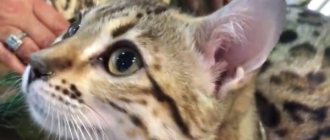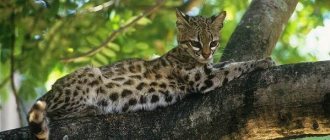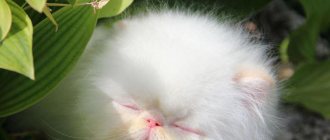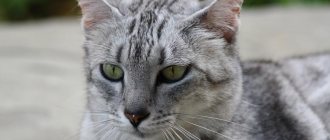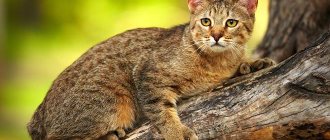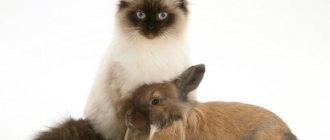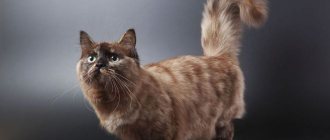The unusual Bengal cat breed was born as a result of the deliberate crossing of wild cats with domestic pets. Every year the popularity of the breed is gaining new momentum - it has already been recognized by many felinological organizations, and also appreciated by lovers of exotic animals. For home keeping, it is recommended to purchase hybrids of the F4-F7 generation, which in behavioral traits are closest to domestic cats. Such pets quickly adapt to society, show “dog-like” affection for their owner and restrain aggression. For other hybrids of wild cats and domestic cats, read the article “Domestic cat lynx and caraquet - hybrids of wild cats.”
History of the discovery of the species
Increasingly, the Asian leopard cat can be seen as a pet among lovers of original and exotic cat breeds.
This is not surprising - cats of this species are extremely charming and beautiful, have a rich history and have several common subspecies that have become very popular among professional breeders and cat lovers. Russian zoologist and traveler, scientist Nikolai Severtsov studied and classified wild cats of Southeast Asia in 1858.
In 1917, his colleague, British zoologist Reginald Pocock, continued the classification of the Russian scientist, dividing wild cats of Asia into four more species. Among them, he especially singled out the Asian leopard and Asian Bengal cat: the latter is still popular among cat lovers.
The Asian cat has many names: Chinese, Javan, golden, dwarf, coin, Ellata, Far Eastern cat and Asian leopard. This is influenced by the scale of distribution and the number of subspecies that live in different regions of Asia.
Ocelot is a common subspecies of leopard cat found in South America.
In this article we will look at the general characteristics of the Asian leopard cat species.
External features
The Asian wild cat is one of nature's most unusual creatures. The thing is that the breed combines the pristine wild appearance of a leopard and the small forms of a domestic pet.
Color
The Asian leopard cat has short hair and a thick coat. The fur of such a cat is soft, it shines, glosses and shimmers beautifully in the sun. The color of the breed in almost all cases is clearly spotted, but will depend on the original habitat of the animal:
- For cats that live in the southern regions, the standard coat is yellow with dark spots on the coat. Such cats vaguely resemble in their color the wilder ancestor of cats - the puma. Also, a similar color characterizes the Asian golden cat subspecies.
Golden color is Temminka’s calling card (Asian golden cat in the photo)
- The Asian smoky cat is a species that is characteristic of the taiga and northern China. These cats have grayish fur, with light and brown spots scattered in strokes.
IMPORTANT: it is noteworthy that the ancient Chinese considered cats with this color to be “coin cats” - the shape of the spots on their fur resembled actual coins.
The Asian leopard cat species has common features: the same arrangement of stripes and spots, regardless of the region of residence, cream or white fur on the sternum and abdominal cavity. On the back, spots form in a line, and towards the end of the tail there are light rings. The tip of the tail of such a cat will always be black.
The fur of "Asians" is shiny and soft to the touch.
Size and weight
On average, an Asian cat weighs no more than 5-8 kg and reaches 47 cm in length. Parameters may vary depending on the place of residence:
- Indonesia: 5-7 kg, 45 cm.
- Far East: 9-16 kg, 60 cm.
- North China: 2-4 kg, 35 cm.
The body of wild miniature predators is slightly elongated, the legs are elongated and muscular: the front legs may be slightly shorter than the hind legs. It is this feature that allows predators to deftly climb trees and climb branches; in a race they can not get tired for a long time and successfully drive in prey. Thanks to their webbed feet, Asian cats are very good swimmers.
Eye color
The eyes of an Asian woman are a separate world. These are large, deep, bright yellow eyes with an amber tint. Sometimes the eye color can be light blue or blue.
Some individuals have blue eyes
Ears, tail
The Asian leopard cat's tail can be as long as half the length of its body. The tip of the tail is always black, the tail itself is pubescent and covered with numerous spots and stripes. The tail length is 15-20 cm, in some cats that live in the taiga it is up to 45 cm.
The muzzle of such cats is short, slightly narrowed, and the ears are rounded. There is a white spot in the center of the outside of the ears.
Exterior of a leopard cat
In terms of physique, the domestic Bengal cat is a muscular, strong animal with developed bones. Every movement of a Bengali is filled with grace and elegance. These cats are unusually stately and beautiful. Bengals have a medium-sized body, with a fairly large head with rounded contours and a strong chin. Representatives of the breed are characterized by high cheekbones, wide-set slanted eyes, a long neck, and a thick tail of medium length. Their hind legs are slightly longer than their front legs, so the cat has a special stance and gait.
The exotic leopard cat has an expressive wild look and small ears tilted forward. The combination of all these features gives it the appearance of a real predator. At the same time, the most memorable detail in a cat’s exterior is its thick, short hair. In appearance it resembles the fur of an Asian leopard cat and can have different colors.
The following color options are recognized by felinological organizations:
- spotted;
- rosette;
- marble;
- silver spotted;
- silver rosette;
- silver marble;
- blue color
The melanistic color is now at the stage of recognition. With this coloring, a Bengal cat whose price ranges from $1,500 for a “pet” class pet will resemble a panther.
The melanistic Bengal has a black coat, on which the rosettes are visible only in bright sunlight.
A domestic leopard cat, a breed that is very popular, may have a pronounced shine to its coat. Glitter is a unique feature of Bengal cats and is recommended in breeding programs.
Character
The Asian leopard cat is primarily a predator, an animal with a naturally wild disposition. The cat is naturally endowed with caution, attentiveness and vigilance. Wild cats do not need company, do not like violation of personal boundaries and never attack first. In nature, the animal hunts for a long time from behind cover, being a born master of camouflage. These cats track their prey for a long time and attack from a secluded place, from where it is extremely difficult to track them without special training.
In terms of taming, an Asian cat kitten gets used to human hands from the first days of life.
By its nature, ACL is a solitary cat; cats of this species form in pairs only to produce offspring, with whom they live for no more than a year.
Pets tamed by kittens get along very well with other felines. They treat dogs a little hostilely, at best just indifferently.
Dogs will not delight Asian cats; they may be neutral or indifferent to them
Rodents, birds and fish will be treated as prey, so it is better not to tease predatory Asian cats with such pets.
Asian cats have no problems communicating with their own kind.
Relationship with the owner
The main characteristic of the Asian leopard cat is the contrast of its wild appearance with developed intelligence, allowing it to quickly find contact with people and other animals.
The peculiarity of the breed is that the cat will single out one owner for itself and will obey only him. She will tolerate other people, family members and especially strangers very carefully, but will not show aggression - rather, she will simply hide in a secluded place.
A “domestic” leopard chooses one patron for itself
The future owner should take into account this feature of the animal and under no circumstances impose communication with others until the pet itself wants it.
The animal also needs constant attention from the owner: it is important to regularly play with the pet, take it for a walk, pet it and treat it. Without this, the Asian cat quickly runs wild and withdraws; any manifestations of attention and touch from the owner begin to be perceived as a threat.
Animals are very mobile, the manifestation of wildness is the need to control what is happening in the territory from above
Despite its independent and wild nature, the breed does not tolerate stress, unfavorable conditions at its place of residence, or travel. Quarrels, loud sounds and sudden movements will be perceived negatively: the animal will begin to withdraw, behave fearfully, and manifestations of aggression are possible. If a cat is nervous, it may begin to get sick and exhibit behavioral disorders.
Trainability
Domesticated Asian cats are incredibly smart: they are very trainable, playful, active and very curious. They have the ability to run, climb, jump and play for a long time, hunt and carry out the owner’s commands. They will be especially intrigued if they receive a treat from their owner.
At home, cats can be very active, tend to climb and climb to high places.
Tolerance for children
An Asian leopard cat will not offend a child, but it will also not allow childish spontaneity to be unleashed and it will not pull itself by the ears and tail. It should be remembered that the animal has a pronounced wild disposition, which lends itself well to taming, but still remains wild. Instincts, along with the love of freedom and pride of cats, will always manifest themselves in such animals throughout their lives.
This is clearly observed in the fact that most of all the Asian cat values its peace and independence. Like all felines, she loves freedom, the opportunity to retire and be away from any fuss. The cat will perceive an encroachment on its personal boundaries as a threat, for this reason living with children is not the best option, especially if the children are no less active and playful.
From Asian Leopard Cats to Bengals
Different species, when crossed with each other, as a rule, cannot produce fertile offspring unless they share a common distant ancestor in evolutionary history.
If you cross a donkey with a horse, a mule will be born, but breeding mules within yourself is impossible, mules are sterile. To get 10 mules, you need to cross a donkey with a horse at least 10 times.
Fortunately, the domestic cat and the wild Bengal cat are not too far apart in their karyotypes (each has 38 chromosomes), which makes it possible to obtain viable offspring from them.
Asian Leopard Cat (ALC)
Asian Leopard Cat (ALC)
Bengal cat
Bengal cats of different colors
To get acquainted with the methodology of breeding Bengals, we will make a short genetic and zootechnical digression.
Crossing in genetics is denoted by the multiplication sign - x. The female gender is designated by the sign + (mirror of Venus), and the male gender by > (shield and spear of Mars). Parental organisms are designated by the Latin word parent - parents. The offspring of crossing two individuals with different heredity is called hybrid.
The hybrid generation is designated by the letter F (the first letter of the Latin word filii - children) with a digital index corresponding to the serial number of the hybrid generation. So, the first generation will be F1, the offspring of first generation hybrids will be designated F2, the third generation will be F3, etc. Well, now let’s return to Bengals, and by “domestic parent” we mean a domestic cat of any breed, be it Egyptian Mau, Abyssinian or any other:
Hybrids of the fourth and subsequent generations are already considered domestic Bengal cats, which can be exhibited at shows in championship classes. When working with Bengals, they try to preserve their “wild” appearance with a kind, “domestic” disposition.
First generation Bengal cat hybrid (Bengal F1)
Second generation Bengal cat hybrid (Bengal F2)
Today, Bengals are active, curious, friendly, intelligent cats. They love to play, climb, run, hunt, wear clothes, and sometimes play pranks and mischief. They develop excellent relationships not only with people, but also with other cats and pets with whom they live together. They love to be the center of attention, play endlessly with their favorite toy, wrestle with a companion, chase prey, or lie lazily on their owner's lap. Even the Bengals' voice is different from that of other domestic cats. Bengal cattery owners describe it as cooing, chirping, or like the sound of gravel pebbles rolling. This is a very musical breed with a wide vocal range that can drop to a squeak in unfamiliar situations. But these are not signs of aggression, but individual means of self-expression. Some of them like to play with water, others like to walk on a leash. Bengals are often chosen as domestic companions by dog owners.
Photo of Bengal cat
Photo of Bengal cat
Currently, Bengals are medium-sized cats, but since they are still “modeled” on wild cats, they must have certain characteristic features. They should have slightly elongated faces with huge, expressive, widely spaced eyes, and many breeders of the Bengal breed insist that the word nocturnal - night, should be present in the description of the eyes of a Bengal cat, since it is this that most accurately describes the characteristic look of a Bengal cat - the look of a nocturnal predator.
Bengals have wide, pronounced beaks, a rounded forehead, a straightened profile, a wide nose with a convex, as if swollen nose mirror, white cheeks and chin, and small rounded ears. They are long-bodied, muscular, and their gait resembles that of a panther: when walking, their shoulders clearly move, their hind legs are slightly higher than their front legs, and they carry their tail very low. They have short, luxurious coats and a wide variety of unusual tabby colors.
Spectacular colors distinguish the Bengal cat from all other breeds. Read more about the colors of the Bengal breed in our article.
Diet of the Asian leopard cat
The Asian cat's diet should include animal foods similar to what cats eat in their natural habitat:
- Beef, poultry, rabbit;
- Mice, chickens (the so-called “live food” can be replaced with chicken feet, heads, hearts and livers);
- Low-fat fish (once a week);
Such cats are fed once a day, with the exception of kittens and pregnant cats - they are fed 3 times a day.
An Asian cat's diet should be balanced.
IMPORTANT: the standard portion for a tamed cat is 150-250 grams of meat, one live chicken and a mouse. Live food helps maintain the mental health and hunting instincts of the pet, which will prevent behavioral disorders in the animal in the future.
Puberty and reproduction
The Asian leopard cat enters sexual maturity at the age of one year, less often at one and a half years. Reproduction of this species occurs regardless of the time of year, with the exception of the northern regions - where natural conditions allow offspring to emerge only in the spring.
Males help females care for their kittens and remain nearby throughout their growing years.
The gestation period for Asian cats is 9 weeks, with a litter of 3 kittens. The kittens begin to see their sight on the 12th day and do not leave the den for a month, feeding on their mother’s milk. At one month, the kittens already taste meat and can leave the den, during which the female and male teach their kittens to hunt and get their own food.
At 10 months, young Asian cats leave their parents and continue to lead an independent life in the wild.
Taming and keeping Asian leopard kittens
Only those kittens that from the first days lived and were raised next to a person can get along with a person. Animals that have already lived in the wild for at least 2 months cannot be tamed and will forever retain their wild, independent character.
Leopard kittens easily take root near people, provided that they get used to home conditions from infancy
The future owner is recommended to castrate the animal upon reaching 6 months, if breeding is not planned. At puberty, a pet can become wild and uncontrollable: this is influenced by instincts that exacerbate the innate “wildness” of an Asian cat.
Like other pets, the Asian leopard cat will need a comfortable and safe sleeping place where the animal can rest as needed.
Regular care and a complete diet containing all the necessary vitamins and elements will keep the animal healthy, support its years of activity, and allow it to live a long and happy life.
Asian cats need walks and play in the fresh air.
Asian leopard cats are very active; they need space and the opportunity to roam freely. The best option is a spacious and comfortable enclosure, which will have two dens inside and a wooden booth with soft flooring for relieving itself. It is ideal if the size and height of the enclosure allow the animal to have loopholes, special shelves and bridges on which the pet can be physically active. There you can also organize a small pool in which the cat can play and cool off in the heat: cats of this type love to swim. During the cold season, “Asians” are moved to a warmer, but no less spacious room.
IMPORTANT: making an enclosure with a glass fence is strictly not recommended. In such conditions, there is a risk of heatstroke.
Many breeders note that animals can live in apartment conditions, but the living space should be spacious and voluminous. An Asian cat needs to be walked in the same way as dogs. During the cold season, cats need to be insulated, as their coat cannot withstand low temperatures.
Bengali temperament
How a leopard cat, the price of which varies from $1,500 to $10,000, will behave in a new family largely depends on the degree of relationship of the animal with its wild ancestors. F1-F3 hybrids can have a wild, unbridled disposition and create a lot of trouble for their owners. They are quite aggressive and distrustful, so they do not get along well with people and other pets.
For home keeping, breeders recommend purchasing F4-F7 hybrids. Such a Bengal cat, whose breed description contains information about its calm, friendly character, can become a true friend. She is distinguished by her inquisitive disposition, self-confidence and activity. Hybrids from the fourth to the seventh generation are affectionate and loyal cats that get along well with other pets and have a high level of socialization. They can be trained to do a variety of tricks and used to being on a leash.
Cats of this breed love to splash in the water and can also safely take a shower or bathe in the bath.
Because of its natural energy, the Bengal cat, which can be purchased from a professional cattery, is very playful and active. Bengals can play outdoors for hours, climb great heights, jump around the yard, and climb trees. You should not expect obedience and calmness from a playful Bengal cat. These are eternal mischief-makers and fidgets, which are ideal for owners leading an active lifestyle.
Bengal cats will appreciate interactive toys purchased by the owner. Even distant relatives of wild Asian cats retain hunting instincts, so cats will happily play games that imitate hunting - chasing balls, catching toy mice, chasing and stalking. Cats of this breed need quite a lot of space for everyday play and the release of physical energy, so the idea of keeping such an exotic pet in an ordinary apartment should be abandoned. He needs a spacious home with access to an open area.
These cats need space to play, as well as all kinds of accessories - wall-mounted scratching posts, playhouses, jute ropes, etc., which will allow the pet to maintain its playfulness and activity throughout its life. In the absence of entertainment and toys, a Bengal cat can become bored and display destructive behavior - turning things in the house upside down, damaging furniture and interiors of rooms.
Health and life expectancy
The Asian predator has a strong immune system: representatives of the breed rarely get sick and are almost invulnerable to chronic diseases. But in this case, no one has canceled vaccination: the first vaccination should be carried out no earlier than 3 months, and the pet must be psychologically prepared for going to the veterinary clinic: sudden stress can cause severe fear, even death.
With proper careful care, the animal can live up to 15 years
Representatives of the breed are prone to getting sick with the VIP virus - this is an immunodeficiency virus that is transmitted from one pet to another. The cat's body cannot resist this virus, so the animal may die.
BENGAL CAT CENTERY “AVENTINUS”
Hello!
Our names are Vladislav and Olga. We are breeders and owners of Aventinus Bengal CatteryTM - a cattery of Bengal cats in Moscow. We are glad to welcome you to our website! We hope that here you will find a lot of useful and interesting information about this wonderful breed.
The Aventinus nursery is officially registered, and also constantly cooperates with the world's leading felinological systems WCF (Germany) and TICA (USA). The main producers of our nursery carry the best and rare blood of nurseries from Canada, USA, Ukraine and Russia.
The main mission of our Aventinus nursery is constant improvement. From the time of our founding to this day, we have been trying to improve and consolidate in our cats such fundamental factors as type, color, character, health and good labor. For us, the Bengal breed, buying a kitten for which, at first glance, does not seem difficult, is an everyday job. We always strive to get the best kittens from the best and correctly selected breeders.
The main producers of our nursery carry the best and rare blood of nurseries from Canada, USA, Ukraine and Russia.
We pay special attention to the health of our pets. All nursery producers are selected especially carefully. Deworming and vaccination of cats and kittens is done on time and only with imported drugs. We exclude and never allow cats and females to be bred without testing for genetic diseases.
Participation in exhibitions is a constant process that requires attention and preparation. Our cats and graduates have conquered the podiums of both Russian and International exhibitions many times. Not long ago GR. I. Ch. Oldrace Oscar - the main breeder - Bengal cattery Aventinus entered the TOP-3 Best Bengal cats in the World according to the WCF system!
Maintaining cleanliness is important. For cleaning, we use specialized products, such as Laina animal disinfectant, which you can buy in Moscow or any other city. The premises are constantly ventilated. If we go to the country or the countryside, we definitely take our cats with us so that they bask in the sun and climb trees - this is a special joy for Bengals.
All kittens from our cattery are ready to move to a new home no earlier than 3 months. For traveling abroad the period is 4 months.
When moving to a new home, the kitten will have:
- De-giltization
- Vaccination against viral diseases (+ revaccination)
- Vaccination against rabies
- International veterinary passport
- Microchip (when sent abroad. In other cases - at the request of the buyer)
- Certificate for export Form 1 (when sending abroad or to another city in the Russian Federation)
- Metric or pedigree (if purchased for breeding)
- Contract for the purchase of a kitten
- Content recommendations
- Gift from the sponsor (feed packaging + filler)
You can choose and buy a Bengal kitten in the Kittens section.
First, you need to contact us in any convenient way Contacts
Expand
